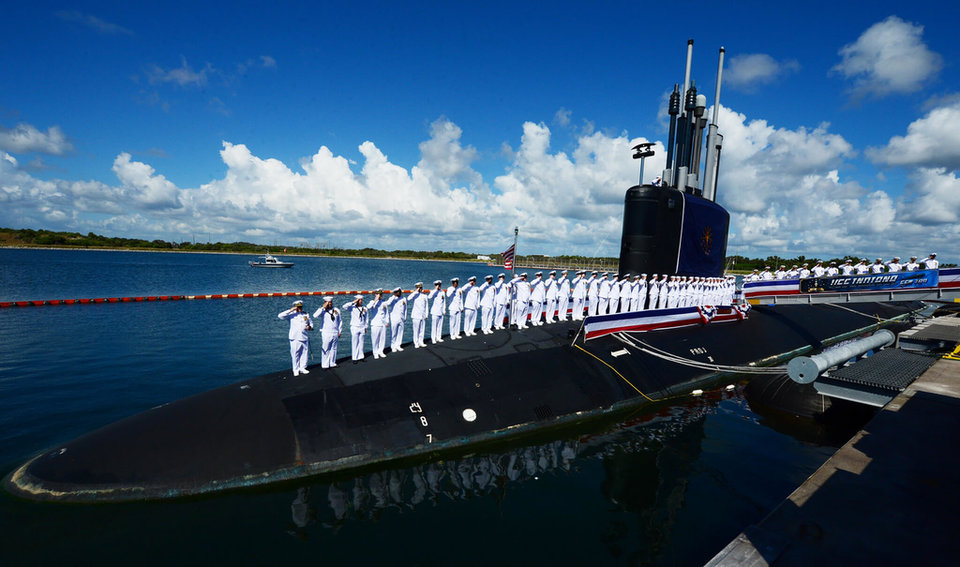sea
Attack sub to underwater spy: A new role for US Navy submarines?
The US Navy is equipping its nuclear attack submarines with improved navigation and detection technology as well as new sonar, automation and AI. This will enable quieter, faster movements in littoral waters but also adds new surveillance capabilities. Andrew Tunnicliffe takes a look at the future roles of the US submarine fleet.
/ The Ohio-class USS Michigan. Image courtesy of US Navy
The US Navy has arguably reached a critical juncture with its submarines. Some military analysts have suggested the gradual retirement of the country’s ageing fleet will lead to a lack of vessels, and more importantly firepower, through the next decade.
With around 71 submarines in active service the US Navy has the biggest fleet in the world. Next-generation submarines are gradually being rolled out to replace the ageing Los Angeles-class fleet and their mission has been extended in response to new undersea challenges.
The Virginia class: a new generation of submarines
The all-rounder of the US submarine fleet, the Virginia-class or SSN-774 which is produced at a rate of two a year, is an attack sub costing in the region of $2,7bn each. It uses so-called ‘fly-by-wire’ capabilities, artificial intelligence and computed automation which allows it to be positioned in shallow waters and not have to surface. It also means the submarine can actively assist captains in maintaining their position, movements, threat detection, and safety.
Using real-time analytics and able to interpret data, once a human command is given to set factors such as depth and the speed, the technology removes the need for an operator to manually sail. Software controls the submarine’s movement by effecting the hardware to maintain the requirements set by the human commander.
“The system analyses the ping it sends out, determining the size, location, and even contours of threats such as other submarines, ships and anything else which may be hostile.”
Virginia-class vessels carry out operations such as anti-submarine, strike warfare, covert mine warfare, anti-surface/ship, and naval special warfare. However, it is their recently enhanced anti-detection and intelligence, surveillance, reconnaissance (ISR) capabilities the navy is particularly keen to use.
These capabilities have been enhanced further in the latest Block III iteration, with improved navigation and detection capabilities and the addition of a large aperture bow conformal array sonar system. The system analyses the ping it sends out, determining the size, location, and even contours of threats such as other submarines, ships and anything else which may be hostile.
In April, the navy awarded Lockheed Martin a $47m contract to upgrade the AN/BLQ-10 electronic warfare system, which enables automatic detection, classification, localisation, and identification of potentially hostile radar and communications signals at sea. It will be fitted to a raft of submarine classes, including Virginia, Los Angeles, Seawolf and Ohio, as well as future Columbia-class ballistic missile vessels.

Virginia-class submarine PCU Minnesota during sea trials. Image courtesy of US Navy
New demands on the US submarine force
Faced with a growing threat from Russian naval forces, and arguably China, the US Navy is ramping up its submarine procurement activity, increasing its fleet, and better using new technologies to allow it to conduct ‘spy’ operations off the coast of enemy states, in near-peer scenarios.
Writing in the ‘Commander’s Intent for the United States Submarine Force and Supporting Organizations’ in March, three top US Navy officials said: “The demands on the United States Submarine Force and supporting organisations continue to grow at an unprecedented rate. The threat continues to evolve and expand rapidly in at least three world regions, each posing substantially different operational demands for both high-end warfighting and peacetime operations.”
“The report emphasised the ability of submarines, particularly US ones, to carry out operations and remain undetected.”
The document emphasised the need for the navy to be ready to confront any threat. “The mission of the US Submarine Force is to execute the mission of the US Navy, in and from the undersea domain. In addition to lending added capacity to naval forces, the submarine force in particular is expected to leverage those special advantages that come with undersea concealment to permit operational, deterrent, and combat effects that the navy and the nation could not otherwise achieve,” the report said.
The report emphasised the ability of submarines, particularly US ones, to carry out operations and remain undetected. But, does the addition of better surveillance capabilities mean the focus of the US Navy for is submarine fleet is shifting?
Perhaps not: the USS Jimmy Carter, a Seawolf-class submarine originally designed during the Cold War, has been referred to as a “spy sub” for some time. Indeed its service and operations log is secret, or at the very least lacking in detail. However, analysts have surmised about the type of work it does, concluding its likely not the “usual” operations. What it does show, however, is that spy mission aren’t new.

USS Indiana is the latest Block III Virginia-class sub to enter active service. Image courtesy of US Navy
The future of the attack submarine
Speaking to CNN in late 2017, former US representative Randy Forbes said: “Stealth capability is one of the crucial advantages of submarines...the Virginia-class brings capability and capacity that is so crucial as we head into potential peer conflict down the road."
The ‘new’ mission of the Virginia-class submarine isn’t a step back from the attack sub; rather, it’s a step into a new future. They are making use of the latest technology, ensuring the attack is more precise, executed more effectively and done so while keeping assets as secure as possible.
Russia and China are both believed to be taking significant steps towards the next generation of attack sub, the US is mindful of that as this strategy suggests.